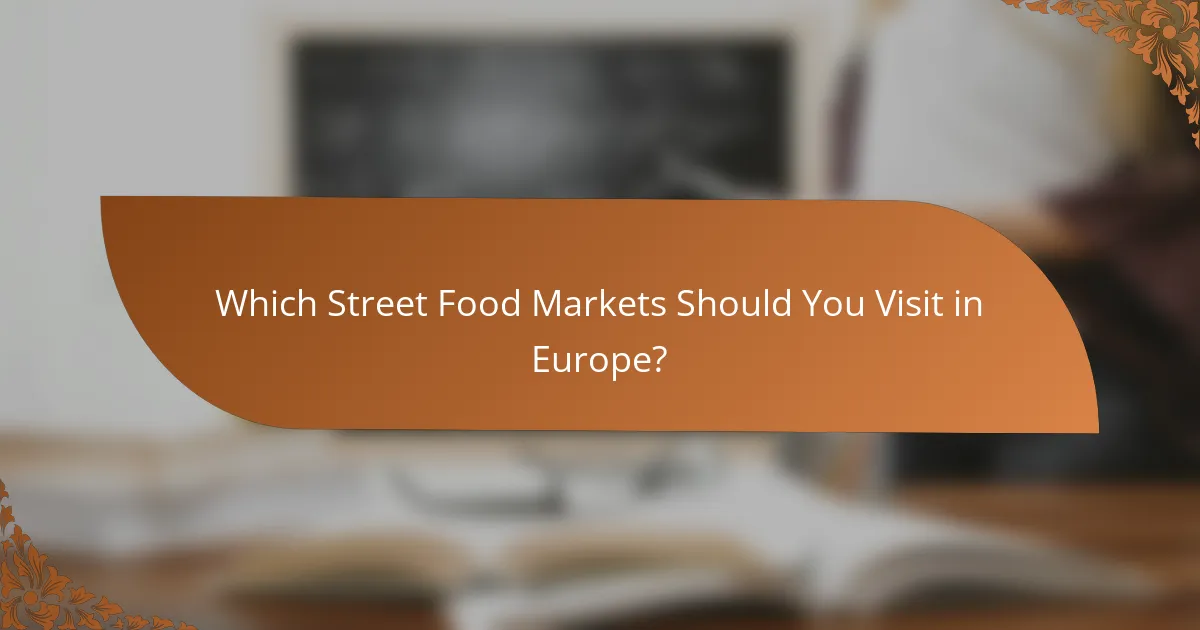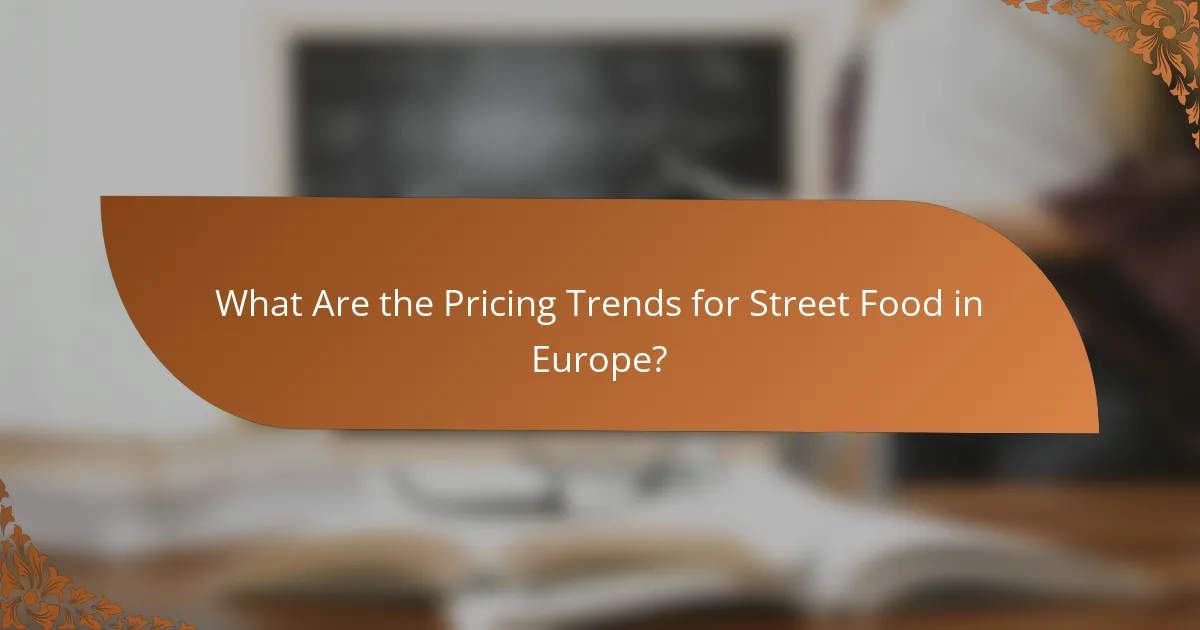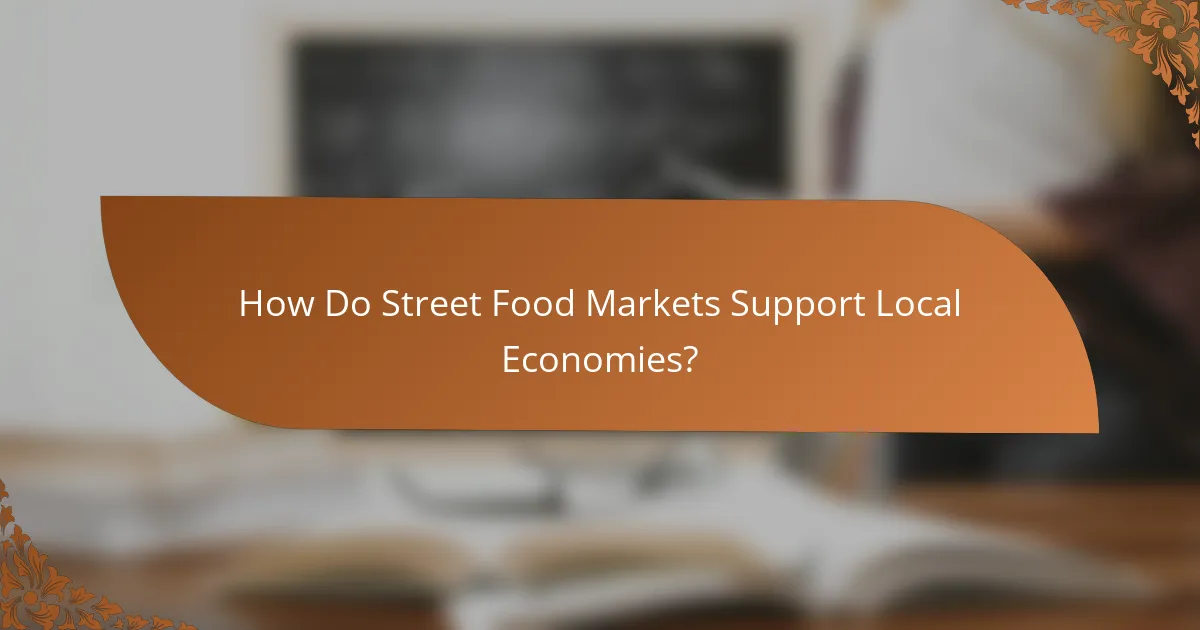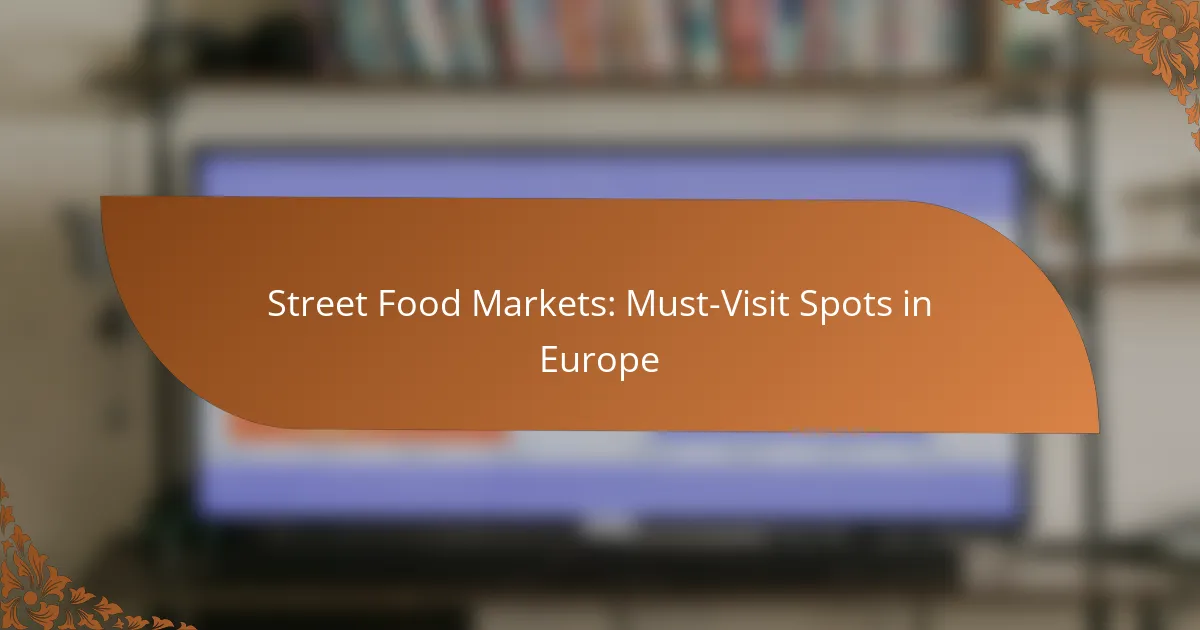Europe boasts a rich tapestry of street food markets that highlight the continent’s diverse culinary heritage. These vibrant hubs not only serve up mouthwatering dishes but also immerse visitors in the local culture and community spirit. From signature delicacies to unique regional flavors, exploring these markets is a must for any food enthusiast seeking an authentic taste of Europe.

Which Street Food Markets Should You Visit in Europe?
Europe is home to a vibrant array of street food markets that showcase local flavors and culinary traditions. Visiting these markets not only offers delicious food but also a chance to experience the culture and community of each city.
Borough Market, London
Borough Market is one of London’s oldest and most renowned food markets, located near London Bridge. It features a diverse selection of food stalls offering everything from artisanal cheeses to gourmet street food, making it a must-visit for food lovers.
Be sure to try the famous British dishes like fish and chips or a classic pie. The market is open Thursday to Saturday, with peak times on weekends, so plan your visit accordingly to avoid crowds.
Mercato Centrale, Florence
Mercato Centrale in Florence is a vibrant hub for both locals and tourists, showcasing Tuscan culinary delights. The market is divided into two levels: the ground floor is filled with fresh produce and local ingredients, while the upper floor features a variety of eateries serving traditional dishes.
Don’t miss the chance to sample local specialties like ribollita or lampredotto. The market is open daily, but visiting during lunch hours can provide a lively atmosphere with plenty of options.
La Boqueria, Barcelona
La Boqueria is a famous market located off Las Ramblas in Barcelona, known for its colorful stalls and fresh offerings. This bustling market is ideal for tasting a mix of local and international street food, including tapas, seafood, and fresh juices.
To fully enjoy your experience, arrive early in the day to avoid the crowds and have the best selection of fresh produce. Be sure to try the jamón ibérico and local cheeses for an authentic taste of Catalonia.
Markthalle Neun, Berlin
Markthalle Neun is a historic market in Berlin that has been revitalized to showcase local food artisans and street food vendors. It hosts various events, including street food Thursdays, where you can sample dishes from around the world.
Visit during the week for a quieter experience, or on weekends for a lively atmosphere. Try the currywurst or a vegan dish from one of the many stalls for a taste of Berlin’s diverse food scene.
Street Food Market, Amsterdam
The Street Food Market in Amsterdam is a dynamic gathering of food trucks and stalls offering a wide range of international cuisines. This market emphasizes sustainability and local ingredients, making it a great spot for eco-conscious foodies.
Check the schedule for specific locations and times, as the market moves around the city. Don’t miss out on trying Dutch specialties like stroopwafels or herring for a true taste of Amsterdam.

What Are the Unique Dishes to Try at These Markets?
Street food markets in Europe offer a variety of unique dishes that reflect local culinary traditions. Each market features signature items that are a must-try for any food lover, showcasing the region’s flavors and ingredients.
Fish and Chips at Borough Market
Borough Market in London is renowned for its classic fish and chips, a staple of British cuisine. Freshly battered fish, typically cod or haddock, is served with crispy chips and often accompanied by tartar sauce and a wedge of lemon.
When visiting, look for stalls that use sustainable fish sources, ensuring both quality and environmental responsibility. Enjoy your meal at one of the market’s communal tables or take it to go for a scenic stroll along the Thames.
Porchetta at Mercato Centrale
At Mercato Centrale in Florence, porchetta is a highlight, featuring slow-roasted, herb-seasoned pork that is crispy on the outside and tender on the inside. This Italian delicacy is typically served in a sandwich, making it a convenient and flavorful option for visitors.
Pair your porchetta with a glass of local wine for an authentic Tuscan experience. Be prepared for a queue, as this dish is popular among both locals and tourists alike.
Jamón Ibérico at La Boqueria
La Boqueria in Barcelona is famous for its Jamón Ibérico, a high-quality cured ham that is a symbol of Spanish gastronomy. This delicacy is made from black Iberian pigs and is known for its rich flavor and melt-in-your-mouth texture.
When sampling Jamón Ibérico, look for the “bellota” variety, which comes from acorn-fed pigs, offering an unparalleled taste. Enjoy it sliced thinly on its own or with a piece of crusty bread for a simple yet satisfying snack.
Currywurst at Markthalle Neun
Markthalle Neun in Berlin serves up currywurst, a beloved German street food. This dish consists of steamed and fried sausage, sliced and topped with a tangy curry ketchup, often served with a side of fries.
For an authentic experience, try it with a sprinkle of curry powder and a dash of mayo. This fast and flavorful option is perfect for a quick bite while exploring the vibrant market atmosphere.
Stroopwafels at Amsterdam Market
At the Amsterdam Market, stroopwafels are a must-try sweet treat. These traditional Dutch cookies consist of two thin waffles filled with a caramel syrup, creating a delightful combination of textures and flavors.
Enjoy them warm, fresh from the vendor, or pair them with a cup of coffee for a cozy afternoon snack. They make for a perfect souvenir to take home, as they are easily packed and enjoyed later.

How Do You Navigate Street Food Markets in Europe?
Navigating street food markets in Europe involves understanding local customs, knowing peak hours, and being aware of payment options. Familiarizing yourself with the layout of the market and the types of cuisine available can enhance your experience significantly.
Best Times to Visit
The best times to visit street food markets in Europe typically align with lunch and dinner hours, usually from around noon to 2 PM and 6 PM to 9 PM. Weekends often attract larger crowds, while weekdays can offer a more relaxed atmosphere.
Consider visiting during off-peak hours, such as late afternoon or early evening, to avoid long lines and enjoy a more leisurely experience. Some markets may also have special events or themed nights that can enhance your visit.
Payment Methods Accepted
Most street food vendors in Europe accept cash, with local currencies like euros (EUR), pounds (GBP), or krona (SEK) depending on the country. However, many vendors are increasingly accepting card payments, especially contactless options, which can be convenient.
Always check in advance if a vendor accepts cards, as some may have minimum purchase requirements. It’s advisable to carry a small amount of cash for smaller stalls or markets that may not have electronic payment options.
Language Tips for Tourists
While many vendors in popular tourist areas speak English, learning a few basic phrases in the local language can enhance your interaction. Simple greetings and phrases like “hello,” “thank you,” and “how much?” can go a long way.
Consider using translation apps or phrasebooks to help with communication, especially in less touristy areas. Being polite and showing interest in the local culture can lead to a more enjoyable experience at the market.

What Are the Pricing Trends for Street Food in Europe?
Pricing trends for street food in Europe vary widely based on location, vendor, and type of cuisine. Generally, you can expect to pay anywhere from a few euros for a simple snack to higher amounts for gourmet offerings, reflecting the diversity of options available across different markets.
Average Costs at Major Markets
At major street food markets in cities like London, Paris, and Barcelona, average costs typically range from €5 to €15 per dish. For example, a classic fish and chips in London might cost around €10, while a gourmet taco in Barcelona could be priced at €7. Prices can fluctuate based on the season and local events.
In smaller towns or less touristy areas, you may find street food options for as low as €3 to €8, making it an affordable dining choice for locals and visitors alike.
Budget-Friendly Options
For those on a tight budget, many street food vendors offer meals under €5. Look for local specialties or smaller portions, which can provide a taste of the culture without breaking the bank. Items like crepes in France or kebabs in Germany often fall into this price range.
Additionally, consider visiting markets during off-peak hours when vendors might offer discounts or special deals to attract customers. Sampling smaller bites or sharing dishes can also help you enjoy a variety of flavors while keeping costs low.
Luxury Street Food Experiences
Luxury street food experiences can be found in upscale markets or during food festivals, where gourmet chefs create high-end versions of traditional dishes. Prices for these offerings can range from €15 to €30 or more, depending on the ingredients and presentation.
Examples include truffle-infused risotto balls or lobster rolls served in artisanal bread. While these options are pricier, they provide a unique culinary experience that blends street food’s casual vibe with fine dining elements.

How Do Street Food Markets Support Local Economies?
Street food markets play a vital role in bolstering local economies by providing opportunities for small businesses and fostering community engagement. These markets create a vibrant atmosphere that attracts both locals and tourists, leading to increased spending in the area.
Job Creation in Local Communities
Street food markets generate numerous job opportunities, ranging from food vendors to support staff. Many vendors are small business owners who hire local residents, contributing to lower unemployment rates in their communities.
Additionally, these markets often require ancillary services such as logistics, cleaning, and maintenance, further expanding job prospects. For example, a bustling market may create dozens of jobs, from chefs to cashiers, benefiting the local workforce.
Promotion of Local Ingredients
Street food markets emphasize the use of local ingredients, which supports regional farmers and producers. By sourcing fresh produce and meats from nearby suppliers, vendors not only enhance the quality of their offerings but also reduce transportation costs and environmental impact.
This focus on local sourcing fosters a sense of community and encourages consumers to appreciate regional flavors. For instance, a market in Italy may feature dishes made with locally grown tomatoes and cheeses, highlighting the culinary heritage of the area.
